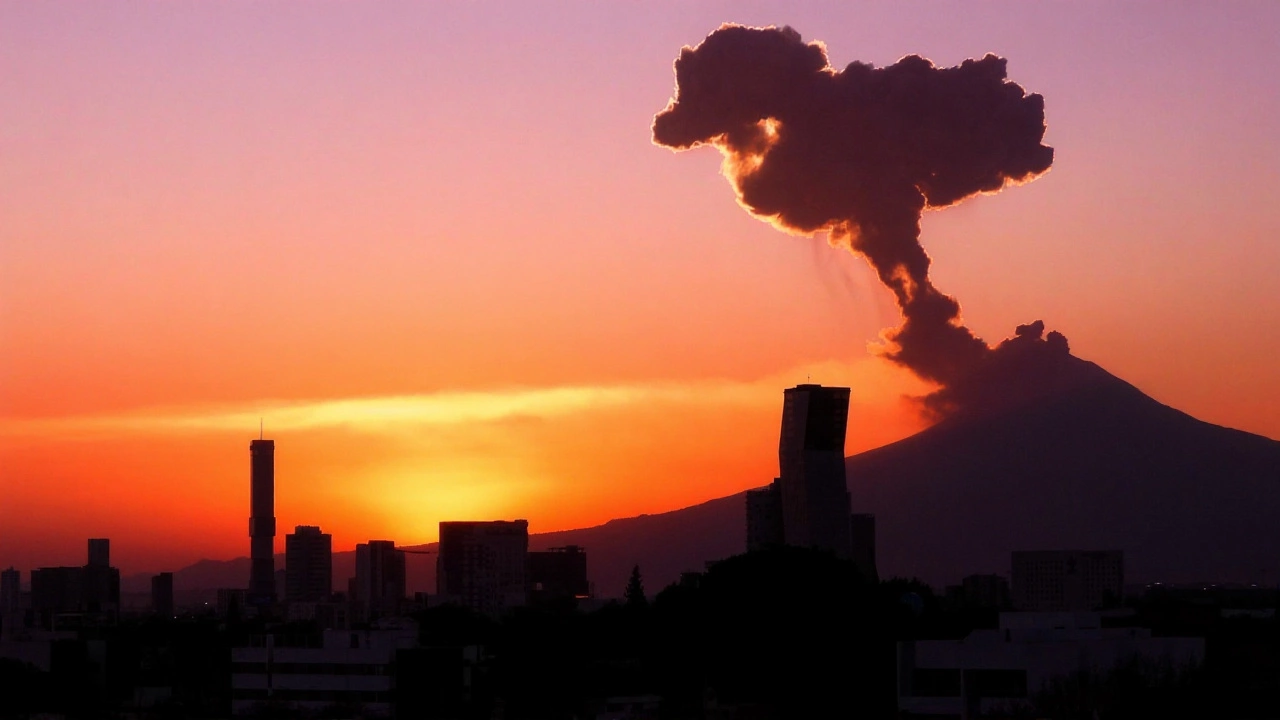Popocatépetl Erupts Again: Ash Plumes Hit 7 km, Yellow Alert Stays

- Oct, 22 2025
- 0 Comments
- Kieran Blackwood
When Popocatépetl, the 5,426‑metre stratovolcano that crowns the borders of Puebla, Morelos and Mexico State, puffed ash into the sky last week, authorities kept the alert at Yellow, Phase Two. The Washington Volcanic Ash Advisory Center reported plumes soaring between 5.8 and 7.3 km from October 17‑21, 2025, forcing officials to remind the roughly 25 million people living within 100 km to stay at least 12 km from the crater. Here’s why that matters for commuters, pilots and anyone with a backyard view of the summit.
What’s Happening on the Volcano Right Now?
The latest episode was logged as Popocatépetl’s October eruptioncentral Mexico. Satellite imagery captured a dense ash column that drifted north‑west toward Mexico City and south‑east toward Puebla, while ground‑based webcams showed the plume’s luminous edge flickering against the sunset.
Seismic monitors run by CENAPRED recorded 9‑58 long‑period earthquakes per day during that window, with tremor bursts lasting anywhere from 57 minutes to over five hours. Steam and gas jets escaped the crater constantly, but only a thin veil of ash coated nearby valleys on September 29‑30, suggesting the current ash spikes are more about wind‑carried particles than a massive explosive blast.
How the Alert System Works
Mexico’s three‑color volcanic alert scale is simple: Green means calm, Yellow signals "increased probability of eruption with limited hazards," and Red warns of imminent major activity. The Yellow, Phase Two level—still in effect—means explosions could hurl ash up to five kilometres high and generate pyroclastic flows within a five‑kilometre radius. That’s why the 12‑kilometre exclusion zone is enforced; it gives residents a safety buffer while still allowing scientists to keep a close eye on the vent.
According to the agency’s protocol, the zone is reviewed every 12 hours. If ash columns breach the five‑kilometre mark consistently, officials may upgrade to Red, which would trigger evacuations in vulnerable towns like Amecameca and even affect flight paths into Mexico City’s Benito Juárez International Airport.
Regional Impact: From Pilots to City Dwellers
For aviation, the Washington VAAC’s forecasts are critical. The centre, operating under the U.S. FAA and NOAA, warned airlines to expect turbulence and reduced visibility on routes crossing central Mexico. Some carriers already rerouted flights south of Puebla, adding an extra hour to the journey but keeping passengers safe from ash‑laden air.
On the ground, the ash settles like a fine gray blanket. In neighborhoods on the northern slopes, residents reported a metallic taste in the air and a thin layer of ash on car windshields. Schools in the affected municipalities have been told to keep windows closed and to monitor air‑quality sensors installed by the local health department.
And then there’s the psychological side. Living under an active volcano for decades creates a kind of uneasy normality. “You get used to seeing the plume,” said Carlos Méndez, a shop owner in the town of San Pedro Ayotzingo, “but every time it gets higher, the nerves tighten a little.”

Why Popocatépetl Is Different From Other Mexican Volcanoes
Popocatépetl, affectionately called "El Popo" by locals, has been churning almost nonstop since its 1994 reawakening. That’s a stark contrast to Iztaccíhuatl, its quieter sister to the north, which only erupts sporadically. The twin peaks are linked by the historic Paso de Cortés, a saddle once used by Spanish conquistadors. While Iztaccíhuatl reaches 5,230 m, Popocatépetl’s 5,426 m summit gives it a slightly larger magmatic chamber, which translates into more frequent dome‑building cycles.
The Smithsonian Institution’s Global Volcanism Program tracks these cycles meticulously. Their database shows that between 2005 and now, Popocatépetl has produced over 30 dome growth episodes, each followed by a partial collapse that sends ash skyward. That pattern explains why the volcano can spew ash at different heights in the same week.
Looking Ahead: What Scientists Expect
Experts say the next few weeks are crucial. Dr. Laura Hernández, volcanologist at the National Autonomous University of Mexico, noted that "the frequency of long‑period events has risen, which can be a precursor to a bigger explosion." She cautions that while a Red alert is not inevitable, the window for a sudden escalation is narrowing as the dome continues to destabilize.
Monitoring platforms like AfarTV’s 24/7 webcam streams are being used to watch the dome’s shape in real time. If the dome bulges noticeably, authorities may raise the alert and expand the exclusion zone to 15 km. Meanwhile, the Mexican Civil Protection System is ready to mobilize shelters in the towns of Ocuilan and Almoloya, should evacuation become necessary.
For now, the best advice for residents is simple: stay informed, keep windows shut during heavy ashfall, and have a mask handy. The volcano may be calm for a moment, but as any local will tell you, Popocatépetl never truly sleeps.

Key Facts
- Current alert: Yellow, Phase Two (as of 2025‑10‑21)
- Ash plume height: 5.8‑7.3 km (19,000‑24,000 ft)
- Exclusion zone radius: 12 km from crater
- Population within 100 km: ~25 million
- Seismic activity: 9‑58 long‑period events per day
Frequently Asked Questions
How does the ash affect air travel?
The Washington VAAC flags any plume that could intersect flight routes. Airlines currently reroute around central Mexico, adding about an hour to trips but avoiding engine damage from ash ingestion. Pilots receive real‑time updates, and the Mexican aviation authority may issue temporary flight restrictions if the plume reaches higher altitudes.
Who is monitoring the volcano and how?
Primary monitoring is done by CENAPRED, which runs seismic stations, gas analyzers and visual cameras. The Washington VAAC provides ash‑dispersion data for aviation, while the Smithsonian’s Global Volcanism Program archives long‑term activity.
What would trigger a jump to Red alert?
A sustained ash column exceeding five kilometres, signs of a major dome collapse, or a sudden increase in high‑magnitude seismic events could prompt authorities to upgrade to Red, initiating broader evacuations and stricter flight restrictions.
Are nearby towns safe right now?
The 12‑kilometre exclusion zone currently covers the most vulnerable areas. Towns beyond that radius, such as Amecameca (≈15 km away), are advised to stay alert, keep windows closed during ashfall, and follow any local emergency directives.
How long has Popocatépetl been active?
The volcano reawoke in 1994 after a 70‑year lull and has been in a near‑continuous eruptive phase ever since, with the current episode having started in January 2005 and persisting for over two decades.